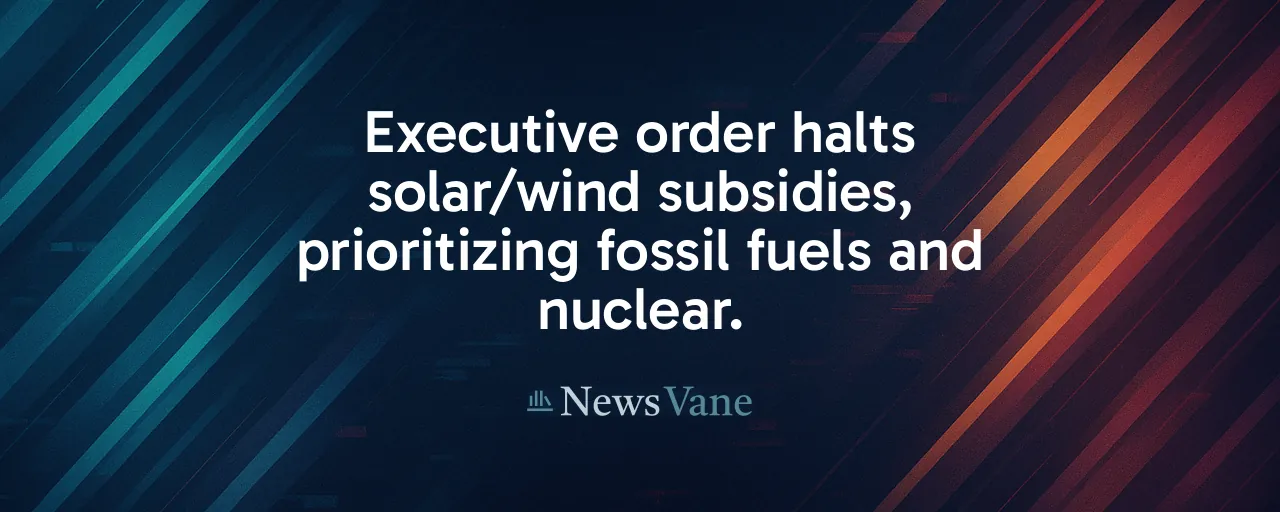A Bold Move Shakes Up Energy Policy
On July 7, 2025, President Donald Trump signed an executive order that sent ripples through the energy sector. The directive, tied to the One Big Beautiful Bill Act, halts federal tax credits for new wind and solar projects and pushes for fossil fuels and nuclear power. It's a decisive step, framed as a way to secure reliable electricity and economic growth. But the move has ignited fierce debate, raising questions about how the nation can meet its energy needs while addressing environmental and economic realities.
The order significantly shifts energy policy priorities. By ending subsidies for wind and solar, it aims to bolster what the administration calls 'dispatchable' energy, sources like natural gas, coal, and nuclear that can run on demand. Supporters argue this will stabilize the grid, especially after events like the Texas cold-snap outages in February 2025, which exposed vulnerabilities in high-renewable systems. Opponents warn that pulling the plug on clean energy incentives could stall progress on climate goals and disrupt jobs in growing sectors.
Why the Shift Matters Now
Energy policy encompasses jobs, security, and the future, beyond simply keeping the lights on. The U.S. generated 18 percent of its electricity from wind and solar in 2024, supported by $17 billion in federal tax credits. These incentives, rooted in the 1992 Energy Policy Act and expanded by the 2022 Inflation Reduction Act, fueled 130 gigawatts of wind and 180 gigawatts of solar capacity. Trump's order doesn't touch existing projects but slams the brakes on new ones, redirecting investment toward fossil fuels and nuclear.
The timing is critical. Global demand for clean energy is surging, and nations like China dominate supply chains for solar panels and rare-earth minerals. Meanwhile, U.S. grid operators face pressure to replace aging coal and gas plants without triggering blackouts. The North American Electric Reliability Corporation warned in 2025 that rapid retirements of traditional plants could strain regional grids if replacements lag. This tension, between immediate reliability and long-term sustainability, defines the current debate.
The Case for Reliable Power
Advocates for the executive order point to real-world failures. During Texas's 2025 winter outages, frozen wind turbines and strained gas plants left millions in the dark. Studies, like the Department of Energy's 2024 report on grid-forming inverters, show renewables can handle up to 75 percent of instantaneous load with advanced storage. But without widespread upgrades, intermittent sources struggle during extreme weather. Fossil fuels and nuclear, by contrast, offer steady output, critical for hospitals, factories, and homes.
Economic arguments also carry weight. The Congressional Joint Committee on Taxation estimates that repealing wind and solar credits could save $180 billion by 2034. For rural communities hosting coal mines or gas fields, the policy promises a revival of jobs and local revenue. Nuclear suppliers, especially those developing small modular reactors, see a chance to scale up, blending reliability with lower emissions. These stakeholders view the shift as a pragmatic fix for a grid stretched thin.
The Cost of Turning Back
On the flip side, renewable energy developers and environmental groups highlight steep trade-offs. The American Clean Power Association projects that scrapping tax credits could cancel 165,000 construction jobs, many in rural areas that voted for Trump. Rhodium Group models suggest power-sector carbon emissions could climb by 400 million tons through 2035, complicating global climate commitments. Higher gas demand might also push retail electricity rates up by 8 percent, hitting low-income households hardest.
There's a global angle too. With China controlling 70 percent of polysilicon and rare-earth supplies, the U.S. risks ceding ground in clean-tech manufacturing to Europe and Asia. Communities near fossil fuel plants, often disadvantaged, could face worse air pollution from increased coal and gas use. These concerns underscore a broader challenge: how to innovate without destabilizing the economy or environment.
Finding Common Ground
Despite the divide, areas of agreement exist. Both sides value secure supply chains and domestic manufacturing. Incentives for grid-scale storage, geothermal, and advanced nuclear could bridge reliability and decarbonization goals. A phased transition, rather than an abrupt end to credits, might give developers time to adapt while preserving grid stability. Technology-neutral policies, which reward emissions cuts regardless of the energy generation method, gain traction among economists as a way to spur innovation without picking winners.
Historical precedent supports compromise. Bipartisan extensions of renewable credits since 1992 built a robust clean energy sector, while Trump's first term eased regulations without dismantling those incentives. Today, workforce programs could train fossil fuel workers for roles in renewables or nuclear, ensuring jobs span all energy types. Streamlined permitting for infrastructure, from pipelines to wind farms, could also unite stakeholders around shared growth.
What's Next for America's Energy
The path forward hinges on execution. The IRS has 60 days to clarify compliance, leaving developers racing to meet 2027 deadlines for existing projects. Grid operators need to reassess capacity to avoid shortages, while courts prepare for lawsuits challenging the order's legal basis. Consumers, meanwhile, will feel the impact through electricity bills and local job markets, whether in solar fields or gas fields.
Balancing reliability, affordability, and innovation remains the core challenge. The U.S. has the resources, from vast fossil fuel reserves to cutting-edge nuclear startups, to lead globally. But sudden policy shifts raise costs and deter long-term investment, as Brookings and R Street Institute studies note. A stable framework, blending diverse energy sources and rewarding efficiency, could turn division into progress.
Energy shapes economic opportunity and global standing, extending beyond just power lines. As debates rage, the focus remains on solutions that deliver for all, from factory workers to families paying utility bills. The choices made now will echo for decades, demanding clarity, collaboration, and a commitment to practical results.
